China Yinchuan City:
Yinchuan
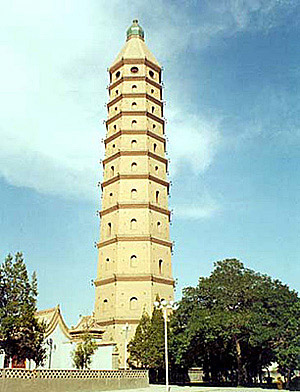
Resident People:953,800 (urban population: 593,800)
General Information:Yinchuan (or Yinchwan), capital of Ningxia Hui Autonomous Region, China, on the Huang He (Yellow River). It is a shipping point for the products of the fertile Ningxia plain.
Geography:Yinchuan is located in the Yinchuan Plain; the middle beaches of the Yellow River, between the Helanshan Range and the Eerduosi Plateau; bounded by Helanshan Range to the west; bordering on the Yellow River in the east.
Yinchuan Map

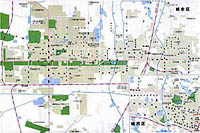
Climate:Temperate continental climate; semi-arid without cold winter and hot summer; 4 distinct seasons, cool south and warm north with great difference in temperature; humid south and arid north; rich sunshine with annual average of 2898-3040 hours decreasing from the south to north; windy and sandy with short and changeable frost-free period of 140-162 days and relative humidity of 50 -65 percent
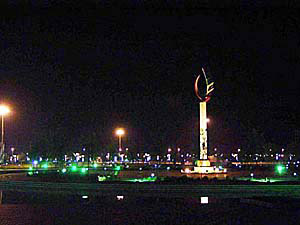
Restaurant:The two large Markets (Dapai dang or Shichang) near the intersection of Xincheng lu and Tiedong lu and the railway station, are some of the best areas to sample the most local of Muslim dishes. Most notable are the spicy and greasy lamb kebabs, the yoghurts and the bread.
The Muslim Beef Spicy Noodle Restaurant (Qingzhen niurou lamian) at the intersection of Zhongshan nanjie and Nanxun donglu. Specialties include noodles and mutton dumplings.
The Xikedeng Fast Food Restaurant (Xikedeng kuaicanting), south of the drum tower on Gulou jie, is clean and has a menu that stretches from Muslim and Chinese food, to mediocre western styles.
The Yinbinlou Islamic Restaurant (Yinbinlou qingzhen fanzhuang) and the Xinyue Fast Food Restaurant (Xinyue kuaicanting) on Jiefang jie are also popular venues for Muslim dining.
The Rainbow Bridge Hotel Restaurant (Hongqiao dajiudian) on Jining jie, south of intersection with Jiefang jie, has a western restaurant of good price and decent standards (for an area of remote China).
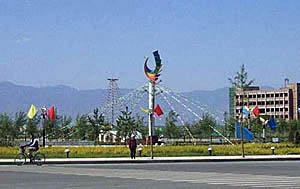
Yinchuan Economy:Yinchuan's industries include machinery, chemical, textile, construction material, food processing. Yinchuan Tire Plant is a major tire plant of China. The chief farm products of Yinchuan are rice, wheat, corn, beet, watermelons, grapes, apples, and Chinese wolfberry fruit.
History:Yinchuan has a history of 1500 years; in 1038, used to be the capital of the Western Xia dynasty called "Xingchuan"; known as "the lush southern-type fields beyond the Great Wall" since the Northern Zhou dynasty; also known as "the phoenix city "; renamed "Yinchuan" in 1944.
Arrive:The city is well spread out, with the New City (Xincheng) in the east of little interest beyond holding the railway station and for its proximity to the airport.
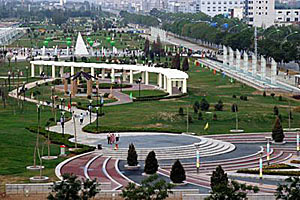
Yinchuan Tourism:This region, the smallest in China, is little visited and little known about, making trips here an interesting and hard experience.
Shopping:Traditional handicraft: flannelette blanket, Helan stone carving; wine, licorice, sheepskin.
Cuisine:Most of the food in Yinchuan is strongly Islamic influenced, since almost 30% of the population here is of the Muslim Hui Minority. Muslim restaurants and food stalls are found on almost every street. The most common of these dishes are of the lamb and beef variety, accompanied by dumplings and noodles, varieties of naan style bread, flagelliform nostoc and blended teas.
Yinchuan Culture:Around 4 million people presently reside in Ningxia, a third are composed of the Muslim Hui Minority, and 930,000 of the total live in the city of Yinchuan.
Yinchuan Attractive points:Chengtiansi Pagoda
Located in the old district of Yinchuan, the pagoda was built in 1050 in the West Xia dynasty. With a height of 64.5 meters, the 13 story pagoda is not only typical but also one of the most well preserved of Buddhist architecture from the West Xia Kingdom. In the temple where the pagoda stands, the West Xia Museum displays cultural relics of the once glorious Kingdom.
Haibao Pagoda
Located in the northern suburb of Yinchuan, Haibao pagoda is believed to have been built in the 5th century. The style of the pagoda is extremely unique, rarely seen in the other part of China. On the top of the pagoda, visitors will have a good view of the Yellow River and Mt. Helan.
Nanguan Mosque
The great mosque lies in the southern suburb of Yinchuan. Built in 1915 and rebuilt in 1981, the typical Islamic mosque covers a floor space of over 2000 square meters. Its chapel can house a thousand praying people.
Shapotou
10 kilometers west of Zhongwei county, Shapotou lies on the bank of the Yellow River. It has an 80 meter sand dune which echoes when one slides down the dune. The place became known because of its success in desertification control program. A 120 meter long desert area has been turned into rich farmland!
West Xia Imperial Tombs
The West Xia Kingdom (1038-1227) was once a power kingdom, which kept a strong military force and maintained its aggressiveness. In 1227, it was conquered by Genghis Khan.
The West Xia Imperial Tombs lie about 30 kilometers west of Yinchuan against Mt. Helan. Nine West Xia kings were buried in the zone, accompanied by hundreds of their ministers. The tombs of West Xia kings resembling pyramids in Egypt are very different from those of Chinese emperors.
There are ruins of the ancient Great Wall, well-known all over the world, passing through Ningxia.
1. The Great Wall in Qin Dynasty from the Warring States Period.
This section enters into Xiji County and Eastern Mount at Guyuan of Ningxia from Jingning County of Gansu and then it enters into Zhenyuan County. The whole section in Ningxia is about 200 km. long.
2. The Great Wall in Sui Dynasty
This section is form the eastern bank of Yellow River at the western part of Lingwu County of Ningxia, via the Heng Shan to Suide Shannxi Province. The section is baout 350 km..
3. The Trench in Song Dynasty
In the war of defence Western Xia at the beinning of the Song Dynasty, the Trench along the Qin Great Wall in the area of Guyuan County was built to prevent the cavalry from Western Xia.
4. The Great Wall in Ming Dynasty
There are four sections in the area of Ningxia:
a. Western Great Wall section. It enters Zhongwei County of Ningxia from the border in Jinyuan of Gansu province, is about 250 km. long.
b. Northern Great Wall section. There are three parts of it according to the records, that is, the ancient Northern Great Wall, Beiguanmen at the frontier defence and Long Dam.
c. Eastern Great Wall section. The Wall on the east bank of the Yellow River and high Rampart on deep ditches - once two defence walls - were built in Yanchi and Lingwu County of Ningxia during the Ming Dynesty.
d.Inner Border of Guyuan. This part was built along the area of Xiamaguan, 150 km. from the north of Guyuan County.
The Xumi Grottoes
The Xumi Grottoes are located at the eastern part of Mount Xumi, about 320 km. south of Yinchuan. Over one hundred caves chiselled out of the faces of the cliffs on five adjacent peaks measuring one by two km.. More than 300 statues of Buddhas and niches dating form the Northern Wei to the Sui and Tang dynasties are in a good state of preservation. In Cave 5 which is located at the inlet of the Xumi Mount, is the 19-metre-high sitting Maitreya, square-faced and large-earred. It looks dignified in the open air. It is the symbol of the Xumishan Grottoes.The Buddhas at the Xumishan Grottoes are similar to the ones at the Yungang and Dunhuang. There are also a lot of inscriptions and stone carvings in the caves dating to the Tang, Song. Western Xia, Jin and Ming Dynasties.










